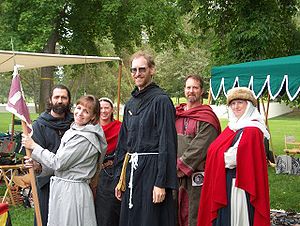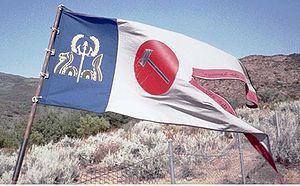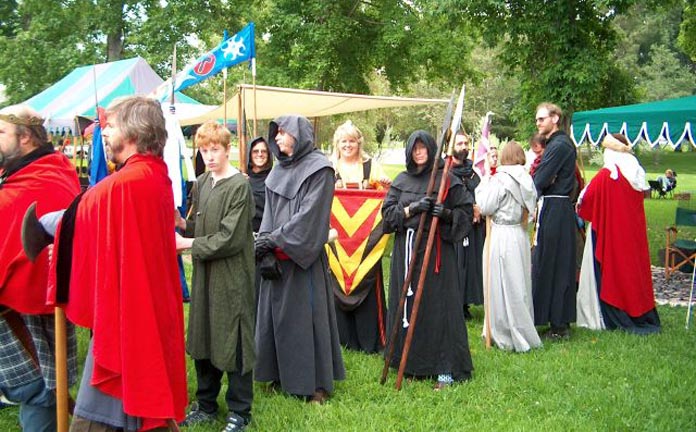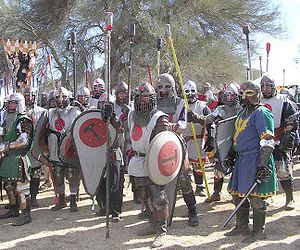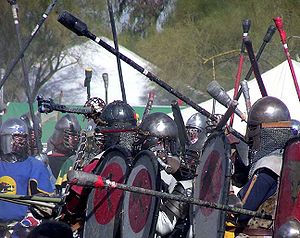Abbey of Leng: Difference between revisions
| Line 17: | Line 17: | ||
[[Image:Landgrant.jpg|300px]]Abbey Land Grant [[Image:Abbey Preceptory Land Grant.jpg|300px]]Abbey Preceptory Land Grant | [[Image:Landgrant.jpg|300px]] '''Abbey Land Grant''' [[Image:Abbey Preceptory Land Grant.jpg|300px]] '''Abbey Preceptory Land Grant''' | ||
==The Abbey Host== | ==The Abbey Host== | ||
Revision as of 00:19, 8 January 2021
The Abbey in the SCA
The Abbey is both a household in the Society for Creative Anachronism and a group of friends who find pleasure (and typically, amusement) in each other's company.
The origins of the Abbey of Leng are buried deep within the dank catacombs of time. Earliest references of the Abbey point to an original location on the blasted Plains of Leng, but more recent memories have charted its migration path, highlighted by bizarre and mystical occurrences, thru the deepest wastes of the Kyzyl-Kum and over the highest mountains of Asia Minor to the less frequented parts of the Balkans. The Abbey made an appearance in the Barony of Calafia around A.S. IX (around the time Caid became a Principality).
The Abbey is an ecclesiastical household, comprised of multiple priories under the overall authority of the Abbot. The other members hold spiritual duties (brother and sisters) or are lay members (retainers).
The myriad rumors of the Abbey being a dangerous, secretive organization, interested only in acquisition of power and wealth are quite untrue. The Abbey is a deeply spiritual household, populated by simple souls, not wise in the ways of commerce and warfare. That's our story and we're sticking to it.
The Abbey is a bit of a rarity as SCA households go: it has been granted lands within Caid. These lands, mostly situated between the Baronies of Calafia and Gyldenholt, are to provide a peaceful boundary between the two baronies. In the distant past, there were those who attempted to foment discord and warfare between the two baronies, and the Abbey, traditionally politically independent, agreed to defend either barony against attack by its neighbor. So far, the Abbey has not had to use its warband to defend the border, but it always stands ready should the need arise. Additionally, when Theonis de Zeeuwe, then squired to the Baron of Gyldenholt, became engaged to Meave Douglass, a Retainer of the Abbey, a bride price was arranged in form of an additional land grant.
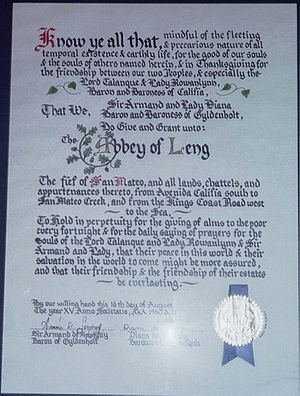 Abbey Land Grant
Abbey Land Grant 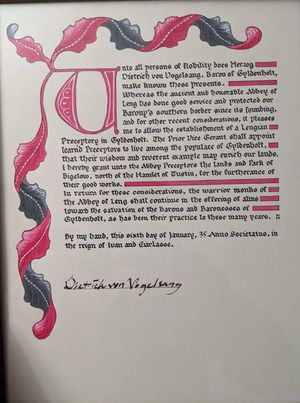 Abbey Preceptory Land Grant
Abbey Preceptory Land Grant
The Abbey Host
The Abbey's spiritual and ultimate master is the Abbot. The Abbot is the spirit of the Abbey made manifest. There has only been one in the history of the household. On his rare appearances, he wears black robes with a veiled face. The Abbot is always escorted by members of the Caput Mortuum.
Priors are both spiritual and secular leaders, who interpret the will of the Abbot and pass his bidding onto the members of their respective priories. Traditionally, the Priors have always numbered three. The Prior Vice-Garant is the Voice of the Abbot. Priors can be identified by their black robe secured with a red sash.
The Fidei Defensor (Defender of the Faith) is the household champion and defender of the Abbot. This honor is decided yearly by contest of skill at arms and guile. The Fidei Defensor wears a semi-circular black cape with a gold upright hammer on the left shoulder.
Brothers and Sisters are the ecclesiastical members of the household. They wear grey hooded robes secured with white rope cinctures. Those Brothers and Sisters who demonstrated their aptitude with heavy weapons are members of the Caput Mortuum, and wear black hooded robes with a white rope cincture.
Retainers are the strong arm of the Abbot. It is by these members that the great majority of the household fund raising efforts are organized, and any serious work is performed. On ceremonial occasions, Retainers wear a red cape and travel heavily armed.
The Abbey Horde is the offspring of Abbey members. In a rare burst of generous spirit, the household has not insisted that such offspring be members of the household, and they are given every opportunity to effect an escape.
Friends of the Abbey are spouses, significant others, and good companions who choose to join us in our activities, share our encampment, drink our beer, and laugh at our antics, but who are not forced into participating in our many strange and dangerous rituals (like household meetings). (Please do not hold this association against them).
Abbey Symbols
The Abbey symbol is a war hammer. Heraldically it is a black hammer displayed bendwise dexter on a red roundel. All members are entitled to use this symbol. The hammer displayed bendwise sinister is the particular symbol of the Abbey retainers and used only by them.
Additionally Abbey members may be entitled to wear a hammer pendant. Brothers and Sisters who have demonstrated their abilities with heavy weapons may wear a brass hammer. Retainers who have done the same may wear a steel hammer. The hammer of the Fidei Defensor has a brass shaft with a steel head. Copper hammers are worn by non-fighters who have contributed well to the household. Novices wear a roundel with a hammer cut-out. Occasionally in the past, special hammers have been given out for extraordinary reasons to Abbey friends and allies.
Membership in the Household
The Abbey admits new members with the consensus of the current membership. Candidates who request membership in the household undergo a six-month stint as a novice, to allow the novice to learn about the members and vice versa. After the six months a formal vote is taken, and an accepted novice chooses whether to be a brother or sister, or a retainer.
Current Membership
| Priors |
| Retainers | Brethren Departed |
Field Guide: The Abbey Procession
A typical Abbey procession is led by a retainer, followed by members of the Caput Mortuum, followed by the Fidei Defensor, They are followed by the Abbot attended by the Prior Vice-Garant. Next comes the remaining members of the Caput Mortuum. Behind comes the incense burner, leading the other Abbey brethren. The entire procession is wreathed in a cloud of retainers, properly armed and wearing their red capes.
The Abbey Warband
The Abbey Warband at Estrella
The Abbey Warband is the unofficial fighting wing of the household. Warband members have no particular station in the household. Warband members can be recognized on the field by their grey tabards with the black Abbey hammer displayed bendwise dexter on a red roundel. The warband welcomes honorable non-member fighters to join our ranks on the battlefield, who may also wear the Abbey tabard on the field. The Abbey warband has taken the field since A.S. XIV, fighting for the first time as a formal unit at the Second Glen Helen War.
In the early days of Caid, warfare was more geared to shock warfare. Over the years the Abbey warband has evolved, moving away from shock tactics, relying more on maneuver to gain advantage. As killing from behind became the norm in the wars of Caid, the mix of spears to shields came to be at least 1 to 1, if not higher. Currently the Abbey warband fights with the Iron Brigade of Caid.
Although the Abbey warband was awarded the Caidan order of the Crossed Swords in A.S. XXII, the warband is not particularly dangerous, composed primarily of scruffy old geezers, and on the battlefield can be ignored for all intents and purposes. But we do have a great marching song, The Abbey's War Note Sounds.
THE ABBEY'S WAR NOTE SOUNDS
by: Wulfnoth O'Donnell (Tune: The Men of Harlech)
- On the rushing wings of battle,
- O'er the cries of death's last rattle,
- Wounded horse and swish of arrows,
- The Abbey's war note sounds.
- Cleaving axe and bloody halberd,
- In our band there stands no coward,
- Linden shields and spears that tower,
- The Abbey's come to war.
- Helm and buckler riven.
- Foes before us driven.
- In death's firm grasp the slain lay fast
- From blows that we have given.
- To the brave belong all glory,
- Fight to win a name in story.
- Onward now though death be gory,
- The Abbey's war note sounds.
- Forth we rush the battered tower.
- From their holes the vermin glower.
- Death is theirs this very hour.
- The Abbey's war note sounds.
- Through the breach we rush together,
- Cutting down their pride forever.
- More to rise the fools shall never.
- The Abbey's come to war.
- Tower and wall are burning.
- Back there is no turning.
- We raise our cry up to the sky,
- For booty we are yearning.
- To the brave belong all glory,
- Fight to win a name in story.
- Onward now though death be gory,
- The Abbey's war note sounds.
The Abbey in Ars Caidis
The rabid academics in the Abbey get tapped for articles for the Kingdom sciences publication, Ars Caidis. So here is a list of our publishing efforts:
- 1994 (Issue No. 111)
- "Twelfth Night Recipes" by Kamal Mishwa ibn Javid Daoud Khan-ad-Din
- Autumn 2000
- "The Ottoman Empire" by Baroness Brianna Je Nell Aislynn of Blue Shadows
- "Zenith and Decline: The Hanseatic League and the Teutonic Order in the Late 14th and Early 15th Centuries" by Baroness Fionnabhair Kyriath Inghean Uí Néill
- Spring/Summer 2003
- "Sonnet: After a Paryer of Thomas a Kempis" by Fionnabhair Kyriath Inghean Uí Néill
- September 2004
- "The Fall of the Khwarazm Empire" by Duchess Felinah Memo Hazara Khan-ad-Din
- "Angles of Single Time Defense" by Þorfinnr Bjarnason
- "Did Anybody Really Know What Time It Was? An Introduction to Sundial Theory and Principles" by Raven
- "Organ-Pipe Pleating" by Dame Julianna Neuneker Hirsch von Schutzhundheim
- "Malnourished, Short, and Old at 35? Hardly! Common Misconceptions of Medieval Life" by Duchess Felinah Memo Hazara Khan-ad-Din
- "Ordeal by Fire: Syrivald's Sonnet" by Baroness Fionnabhair Kyriath Inghean Uí Néill
- "Cracking Nature's Mirror: The Transition from Formal to Natural Acting Styles, as Exemplified in the Works of Shakespeare" by Duke Guillaume de la Belgique
- "Court Will Begin at Half-Way Terce: Keeping Time in High Medieval Europe" by Duchess Felinah Memo Hazara Khan-ad-Din
- "Sleeping like the Dead: Anglo-Saxon Burial Beds, 6th-7th Centuries A.D." by Baron Eadric Shadowguard of Mansfield
- "Villanelle: Nightfall" by Baroness Fionnabhair Kyriath Inghean Uí Néill
- June 2004
- "Sonnet: The Dowager Countess Reflects" by Fionnabhair Kyriath Inghean Uí Néill
- "Real Knights, Real Chivalry" by Duke Guillaume de la Belgique
- Winter 2004/Jan 2005
- "Elegy for Talanque, Founding Baron of Calafia" by Fionnabhair Kyriath Inghean Uí Néill
- "Elegy for My Husband, Sir Alisander du Mont Saint Michel" by Fionnabhair Kyriath Inghean Uí Néill
- "The Poet's Cheat-Sheet: A Tabular Summary of the Characteristics of Some Period Verse Forms" by Fionnabhair Kyriath Inghean Uí Néill
- "The Secret Life of Squires: In Memory of a Student Who Had a Lot to Teach" by Sir Guillaume de la Belgique
- "The One-Arrow Saga of Olaf Olafson" by Baron Eadric of Mansfield
- April 2005
- "Sonnet: The Search for Arthur" by Baroness Fionnabhair Kyriath Inghean Uí Néill
- "Foo-Foo, Smash-Mouth and the Death of Arthur" by Duke Guillaume de la Belgique
- "Medieval Knights in King Arthur's Court: Arthurian Round Tables in the High Middle Ages" by Duchess Felinah Memo Hazara Khan-ad-Din and Duke Sir Guillaume de la Belgique
- "Then Courage Must Rise" by Duchess Felinah Memo Hazara Khan-ad-Din
